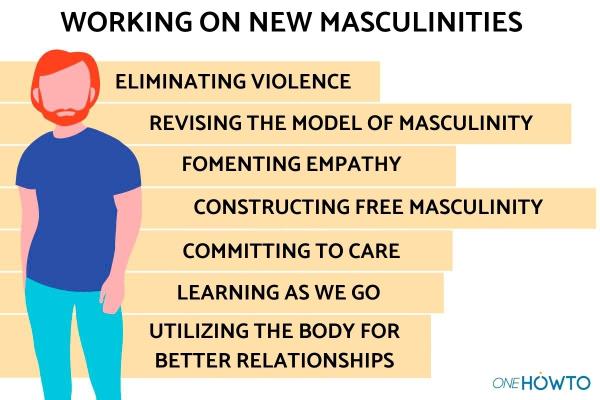What Are the New Masculinities?


Throughout history, a hegemonic definition of masculinity has been pervasive. The idea of maleness has traditionally been expressed in traits such as strength and the ability to protect, but also in emotional reticence and even violence. Such limited concepts and rigid definitions may be pervasive, but the actual events of history prove they are often incorrect. Furthermore, they can be detrimental to both an individual's idea of their own masculinity, as well as how they influence larger societies. While such definitive definitions have been challenged, it has taken time for more nuanced views of masculinity to be generally accepted.
With this context in mind, oneHOWTO asks what are the new masculinities? We look at the concept behind new masculinity and how they differ from previous characteristics related to manliness.
What are the new masculinities and their benefits?
The new masculinities propose a rethinking of the traditional idea of masculinity. This requires the unlearning of strict gender roles imposed throughout life and inherited over the centuries. The concept of the hegemonic man is no longer useful. Most of society has understood that it does not fit reality, hence the need to look for alternatives to this model with a more nuanced gender perspective.
Institutions, organizations, companies and individuals are working together to reformulate the classic archetypes of masculinity. One of the most necessary and beneficial points of interest of the new masculinities is the eradication of both gender violence and those attitudes that favor it. Another important aspect on which they focus is breaking the myth of the omnipotent and violent man, as well as the rejection of all machismo behavior that appears in everyday life.
To put an end to attitudes of gender violence, new attitudes toward empathy, family, work and personal co-responsibility are essential. This implies a masculine presence particularly in terms of care and attention of other people.
Differences between traditional and new masculinities
The new masculinities present evident differences at a conceptual level in respect to the traditional types of masculinity. These include traditional aspects such as competitiveness, inequality, gender roles, aggressiveness and external image:
Competitiveness
An important part of traditional masculinity consists of the need to demonstrate one's abilities. For example, competition in education is used in order to achieve higher social or employment status. New masculinities consider that each person can expose their weaknesses without fear and take advantage of the talent of their colleagues to achieve effective collective work without seeking confrontation.
Inequality
Traditional masculinity has the culture of inequality as one of its main tenets. It is based on the idead that control over people is required to have power. The new masculinities are committed to consensus and horizontal dynamics in relationships between equals.
Gender roles
The concept of traditional masculinity is defined as the opposition to the feminine, i.e. men have to provide, they do now show care, do not emote, etc.
However, the new masculinities and feminism are committed to the elimination of these gender roles imposed on masculinity and femininity with the aim of promoting freedom. When applied to aspects of masculinity such as fatherhood, it provides a healthier experience for the entire family.
Aggressiveness
The most negative aspects of hegemonic masculinity include violence and aggressiveness. Despite being increasingly illegitimate, they are still present in today's society. They may take the form of physical violence, sexual violence, harassment, intimidation or even violent language. New masculinity aims to eliminate sexist violence and any other type of male violence.
Outside image
The traditional masculine referent tries to project a certain public image which contributes to the development of competitive and instrumental skills. It is a positive aspect for productive work, but it entails a personal and inner carelessness that can causes poor management of emotions.
The new types of masculinities seek a balance between internal and external development. They favor optimal management of emotions and interpersonal relationships.

How to implement new masculinities
To assimilate the new masculinities into the male character, we provide the following goals:
- Eliminating Violence: changing violence and power to better change the way we inhabit the world. Do a personal review to eradicate the learned representation of how to be a man and move on to a perspective of individual being.
- Revising the model of masculinity: asking ourselves what masculinity is and realizing that hegemonic masculinity is obsolete. We must put aside all asocial behaviors so that new ways of expressing feelings can emerge.
- Fomenting empathy: can be done by listening and feeling, being in contact with other people and connecting with deeper emotions.
- Building a free masculinity: there are no concrete formulae for new masculinities. Don't try to control or define everything, just enjoy things naturally.
- Committing to care: we must get involved in complete care that goes beyond paternity. It is about building a masculinity based on balanced relationships, living care and upbringing in our own spaces.
- Learning as we go: this is not about constantly competing. Enjoy learning from everything, even from your own mistakes. Read, talk to friends, educate ourselves and share concerns to move forward in life.
- Utilizing the body for better relationships: do not be afraid of physical contact with other people. We are a body and a skin. Break the shell of distance, the one that prevents us from giving hugs with feeling.
If you want to read similar articles to What Are the New Masculinities?, we recommend you visit our Culture & Society category.





